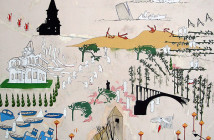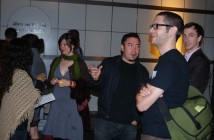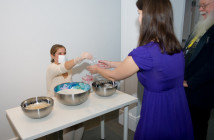ASKEW @ 215 COLLEGE ARTISTS' CONTEMPORARY GALLERY
Featuring the work of Paul Humphrey, Jennifer Koch, Tarrah Krajnak and Lance Richbourg, Askew: Contemporary Portraits lays out four different approaches to contemporary portraiture, all of which are intertwined in some level of appropriation. Using this method as a basic platform, each of these artists use found imagery to present ideas through the most familiar thing we know - the human face and body. However, while all of these portraitists cobble together source material, they also use the their unique method and incarnation of the portrait to share something larger, a personal brand. Thought it would be reasonable to refer to the work of these four purely as appropriation artists, this sampling of portrait work not only appropriates, it re-presents, transforms, redeems, fetishizes, distorts, embellishes and combines found imagery and objects in the task of presenting an identity.
As abused as the genre (or notion) of appropriation is, what is relevant is that viewership of this work is guided by a postmodern and postconstructuralist view, with or without recognition of the fact. The element of found or appropriated imagery is not necessarily what we see in the pieces initially, and perhaps more importantly, is hardly significant to the pieces themselves, but more a carrion of our age. Implicit or pre-loaded in our aesthetic equipment is a history of adapted images, challenged notions of authorship and originality, and conflicts arising from determining "eternal value". For this, we can credit the now ubiquitous use of replication through photography's capacity for multiplicity, and the use of the internet as a visual tool.
No longer expecting a work of art to be the a singular, original creation as produced from an isolated ego, a contemporary audience recognizes the influence of our world's proliferation of images and information. In fact, the expectation is that of the opposite, that artists must be pulling from (or at least aware of) a fractured, global image base. Thus the choice of Askew for the title of the show speaks to this subtle re-arrangement, a desire to slightly alter the existing arrangement from the way it might have come pre-packaged.
Because one can't identify the source material, upon first view, Paul Humphrey's paintings appear to be about borrowing images. Since the source material is not recognizable, one might not consider them on first view - based on the logic of the show. On view are his Sleeping Beauties series, which displays women - largely face and upper torso - enveloped in sleep. These Beauties, produced in a 12 year period from 1987 until his death in 1999, are largely created from media clippings. Some of these images more recognizable than others, such as media figures and pop icons, while others are purely fictional creations such as his alleged daughter, Sandra Sue. All figures, however, are embedded within a carefully crafted aesthecic, resulting from a reconstruction of their faces - in many cases, in the same manner as reconstructive surgery.
Using simple and consistent methods to change and alter the faces from sleeping to awake, all of the images take on the same visual aesthetic. First, there is the closing of the eyes and small face alterations accomplished with white out and graphic design tape, drawing and shading, sometimes with charcoal from burned matches. Each piece is then photocopied, and color is added as a last step.
The element that remains fascinating and disquieting about Humphrey's work moves beyond his all consuming process to the sheer volume and consistency of the of the series, exposing a tender, but never the less obsessive tendency. Humphrey's work is a kind of ultimate transformation, an irreconcilable inclusion or aesthetic indoctrination that places all images distinctly inside a series - like a mold or moss enveloping objects so they becomes unrecognizable from their original. Though not sinister, the level of persistence and consistency is overwhelming. Humphrey, whose work has been considered an outstanding example "outsider art" and since his death has been exhibited nationally and internationally.
-
Tarrah Krajnak uses the seamless medium of digital imagery to smooth together found images and create entire fabricated individuals. In this series, Girls and Boys, the products of this amalgamation are in rich ultrachrome prints presented in 2.5D (that's two-and-a-half-D). This method of both printing with a sense of depth and physically lifting the image from the background support places the artwork somewhere between the safe rectangle of the piece and being invasive to the viewer. The figure's presence is contained, yet volatile.
In each piece, the found relatives, images brought together from both contemporary and historical pornography, and various other source materials including images from tin types, are formed together to create transgender figures in various levels of undress, provocation, and exposure. All equipped with gender neutral names, these figures are defiant - as well as at times painfully self conscious. In each, there is a level of intensity - of awareness of being on view. Krajnak employs Laura Mulvey's theory of the gaze to simultaneously objectify the figure and grant the viewer hyper awareness of their own voyeurism. Not only are Krajnak's figures combinations of actual imagery, but they are a hybridization of medium - sampling from a wide spectrum of photographic techniques.
-
In a much different vein, painted on the floor by tying a paintbrush to a longer stick to allow more flexibility, Lance Richbourg executed The Marilyn & Joe series. The subject matter, struck from the artists connection with the professional baseball world and his interest in Marilyn Monroe's love life and husband, Joe Dimaggio, is a rendition of our American pop icon borders on irreverence. In method, its easy to see that Richbourg has trained formally as painter; there is a clarity and lushness to his line that appears classic despite their use of low brow newspaper color adds as a support. Tooled as free hand renderings of old pin ups, Richbourg not only borrows his subject matter, he also places her in a context of every day vernacular imagery, of practical imagery.
Noting this magical transformation from low to high, this subliminal process where trash is converted to a noble object, how do we see Richbourg's use of newsprint? At first, the artist's use of circulars from local newspapers came out of convenience at first, then moved into a conscious selection of materials. So what does this action of Marilyn Monroe's fleshy, richly rendered face bobbing in and out of commercial newsprint grant us? Richbourg is making the transparent connection between the visual act of selling commodities and the visual transformation that an icon makes - from actual subject to icon. Her face emerges in varying levels from the every day commodities. This blend of pop culture with and pop icon in the merging of skillful painting and vernacular appropriation lifts the newsprint aesthetic up and makes it participatory in a fine art context.
-
Like Richbourg, Jennifer Koch's relationship to found material is more redemptive than appropriation based, the objects assuming value that they would not have had otherwise. In this exhibition she presents two pieces that are a continuation of the "Specimen" series, #59 after St. Gerard and #60 after School of Fontainbleau Gabrielle d'Estrees and One of Her Sisters, 1590, and one which is an extension of the series but that is also starkly different, a box construction Currin Re-Do after Rachel with Fur John Currin, 2002.
While #59 is an ideal example and fully realized addition to the series, #60 is a slight derivation. A fleet of Barbie doll heads, (or their modern incarnation), some clearly historical objects from the 1960's some more contemporary, reach out with disembodied arms to a pristine cluster of white objects on the right. Mimicking in gesture the oil painting below, the inclusion of the objects disrupts and complicates the possibility of reading any narrative. The image taken from The School of Fontenbleau is peculiar and erotic, the inclusion of the ring in the right figure's hand invoking some kind of exchange - other than sexual - between Gabrielle, a mistress of the Henry the IV and her sister. However, this original narrative that referenced the birth of Cesar, is interrupted- as viewers we are not able to decode the painting fully, but rather engage in the new narrative introduced by the three dimensional objects. The sea of plastic faces and arms reach, seeking connection.
Koch's newest incarnation of portraiture, Currin Re-Do, replicates and transforms a 2002 painting by John Currin from Painting People: Figure Painting Today, a survey of contemporary painters. It is an important departure from history painting appropriation, borrowing instead from contemporary art. Rather than feeling like a sacred cash of objects, the addition of objects in this piece feels like a kinetic projection, a psychic continuation of the portrait. The singularity of the added objects focuses the piece further. Relevant about this piece is that in borrowing from contemporaries, it is possible to mistake the appropriation for the original. As Sherry Levine photographed other photographs, Koch's image appropriating leans more on concept than on pure visual engagement, as it does with her previous Specimens. Fluid and without boundary, Kotch's aesthetic creates a working model for how to navigate visual culture - to make it your own.
- of work from the artists (clockwise from top left): Lance Richbourg, Tarrah Krajnak, and Jennifer Koch
215 College Artists' Cooperative Gallery
"Askew Contemporary Portraits" is on view October 10 - November 9th, 2008 at 215 College Artists' Cooperative Gallery .





